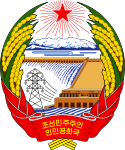Constitution of North Korea: Difference between revisions
mNo edit summary |
No edit summary |
||
| Line 2: | Line 2: | ||
The '''Constitution of North Korea''' currently in force dates from [[September 5]], [[1998]] and lays out the framework of the national government and the functions of the [[Workers' Party of Korea]] in relation to the government's operations. It establishes North Korea as the "Democratic People's Republic of Korea" (DPRK) and a socialist state. It issues guarantees of [[freedom of expression]], right to elect officials, right to a fair trial, and [[freedom of religion]]. It asserts the right of every citizen to work, education, food, and health care. In reality, very few or none of these are actually [[Human rights in North Korea|respected by the government]]. The new constitution can be characterized as the institutionalization of military rule. In the several years since [[Kim Il Sung]]’s death, [[Kim Jong Il]] has ruled North Korea as commander |
The '''Constitution of North Korea''' currently in force dates from [[September 5]], [[1998]] and lays out the framework of the national government and the functions of the [[Workers' Party of Korea]] in relation to the government's operations. It establishes North Korea as the "Democratic People's Republic of Korea" (DPRK) and a socialist state. It issues guarantees of [[freedom of expression]], right to elect officials, right to a fair trial, and [[freedom of religion]]. It asserts the right of every citizen to work, education, food, and health care. In reality, very few or none of these are actually [[Human rights in North Korea|respected by the government]]. The new constitution can be characterized as the institutionalization of military rule. In the several years since [[Kim Il Sung]]’s death, [[Kim Jong Il]] has ruled North Korea as commander |
||
in chief of the Korea People’s Army (KPA), and has maintained military rule. The status of the military was enhanced and it appeared to occupy the center of the North Korean political |
in chief of the Korea People’s Army (KPA), and has maintained military rule. The status of the military was enhanced and it appeared to occupy the center of the North Korean political system; all the social sectors were forced to follow the military spirit and adopt military methods. Kim Jong Il’s public activity focused heavily on on-the-spot guidance of places and events related to the military. |
||
{{wikisource|Constitution of North Korea}} |
{{wikisource|Constitution of North Korea}} |
||
Revision as of 07:44, 27 December 2007
 |
|---|
|
|
The Constitution of North Korea currently in force dates from September 5, 1998 and lays out the framework of the national government and the functions of the Workers' Party of Korea in relation to the government's operations. It establishes North Korea as the "Democratic People's Republic of Korea" (DPRK) and a socialist state. It issues guarantees of freedom of expression, right to elect officials, right to a fair trial, and freedom of religion. It asserts the right of every citizen to work, education, food, and health care. In reality, very few or none of these are actually respected by the government. The new constitution can be characterized as the institutionalization of military rule. In the several years since Kim Il Sung’s death, Kim Jong Il has ruled North Korea as commander in chief of the Korea People’s Army (KPA), and has maintained military rule. The status of the military was enhanced and it appeared to occupy the center of the North Korean political system; all the social sectors were forced to follow the military spirit and adopt military methods. Kim Jong Il’s public activity focused heavily on on-the-spot guidance of places and events related to the military.
